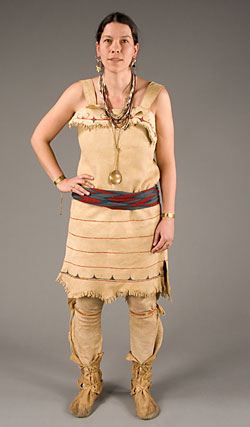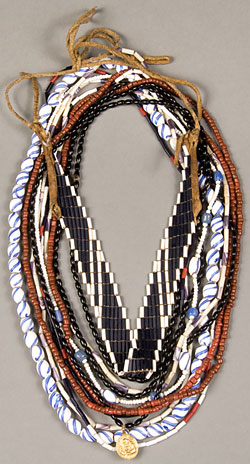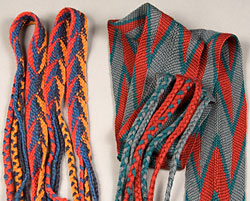




Advanced Search
Dress Up | 1st Person | African American Map | Now Read This | Magic Lens | In the Round | Tool Videos | Architecture | e-Postcards | Chronologies Turns Activities
Wôbanaki Women's Clothing from 1700Wôbanaki people did not have special clothing for sleeping. They slept in what seemed most suited for the season. In the winter this would mean wearing several layers to bed and in the hot weather one might sleep without clothing. Wôbanaki people believed it was a good idea to protect sensitive areas of the body, such as joints, the neck, ears and face, with jewelry, garters, and tattoos. By these means, they believed that dangerous energy or spirits could not enter their bodies. Jewelry with complicated patterns, reflective surfaces, and dangling and jangling pieces such as bells or metal cones, all helped to confuse harmful forces. Porcupine quill embroidery, beading, fringe, and ribbons might be added to the edges of clothing, both to offer protection and to encourage connections with desirable plants and animals.. For instance, the hem of a skirt might be decorated with ribbon, or the flaps on a pair of moccasins might be decorated with beads or porcupine quill embroidery. Among the numerous items available through trade in the 1700s were wool and linen cloth, ready-made shirts and coats, knitted wool hats and mittens, glass beads, brass kettles, paint pigments such as vermillion, and metal axe and spear heads and knife blades. Native American people in New England would trade with the French in New France or the English in the American colonies. Items they received might come from England, France, Holland, or as far away as India. Go to interactive Flash version
DressThis dress is made of deerskin with painted designs. TattoosTattoos were put on the body for a variety of reasons. On men, some were marks of valor, and others were used to cover skin injuries or were placed on powerful parts of the body such as around the eyes, on the chest, joints, or the fingers used to draw a bow or pull the trigger of a gun. Tattoos were also used to deaden nerves, to relieve various aches, and to attract healing energy to specific parts of the body.. Generally, Wôbanaki women did not have as many tattoos as men did.
Comb & MirrorThe comb and mirror are trade items. The mirror is called a “pipinawiakwigan”. The comb, called a “naskuahon”, is made of cow horn.
LeggingsThese are deerskin leggings, called “medasal”. They are tied to a belt at the waist to keep them up. Leggings were worn for warmth and to protect one's legs when walking through scratchy undergrowth. MoccasinsThese are winter moccasins, made of deerskin. Unlike the summer moccasins, which have a seam in the center on top, winter moccasins have no center seam because it would cause blisters when wearing snowshoes. Instead, the seam is placed along the top edges of the moccasin. The Abenaki word for all shoes, including moccasins, is "mkezenal".
Earrings & BraceletsJewelry was worn by men and women. The earrings, “saksohanal”. and bracelets, called “wpedinibial”, are made from a brass kettle. There are also white shell beads on the earrings.
NecklacesThis woman wears a variety of necklaces. A necklace is called a called “nôpkoan”, a thing that circles. Several of these “nôpkoanal” are made from glass beads and one strand is wampum, cylindrical beads used for jewelry, ceremonies, and currency, that are called "wôbôbial". The purple beads are made from quahog clam shells collected from the New England seacoast. The white beads are made from whelk shells. She also wears a woven necklace of blue and white glass wampum.
SpoonThis is a brass spoon received in trade. It is being worn around the neck for convenience.
Sash & GartersThis woman wears a sash around her waist and garters, called “kiganibial”, tied on just under her knees. The sash and garters are made from wool yarn, using a technique called "fingerweaving". As the name suggests, fingerweaving is a way to weave by using the fingers, instead of weaving on a loom. The garters help to keep the woman's leggings in place.
CapotThe French call this kind of hooded coat a "capot". The Wôbanakiak call a large overcoat like this a "kchi pikizon". It overlaps in front and is kept closed with a brass hook and eye. Capots were usually kept closed with buttons, so the hook & eye might have been a replacement. A sash also holds the capot closed at the waist. This capot is made of wool. Originally worn by sailors as raincoats and adapted for use in the woods, they were very popular in the Indian trade. BlanketThis wool blanket was received in trade and is being used as a bedroll. MittensThese are wool mittens received in trade. Mittens are called “meljasak”. KettleThis is a brass kettle, received in trade from the French. It can be used for cooking, or it can be cut up into shiny metal to be used for jewelry. PouchThis pouch has been decorated with white glass beads, paint, and a tuft of deer hair dyed red. The pouch might contain tobacco and materials needed to start a fire, such as a steel striker and flints.
PipeBoth men and women smoked pipes, using various smoking mixtures for healing purposes, for relaxation, and for prayer. This pipe is made of stone.
KnifeA knife could be used for a variety of tasks, from cutting food to carving wood or basket splints. The sheath is decorated with white glass beads and paint. The wooden barrel-shaped bead serves as a toggle to help keep the knife on a belt.
|
| |
Home | Online
Collection | Things
To Do | Turns Exhibit | Classroom | Chronologies My
Collection
About This Site | Site
Index | Site Search | Feedback









